Chalices - The Pectiniidae Family

Family:
Pectiniidae
Common Genus:
Echinomorpha, Echinophyllia, Oxypora, Mycedium, Pectinia, Physophyllia
Common Names:
Chalice, Lettuce Coral, Plate Coral
Chalice corals are not corals of a single species, from a single genus or even from a single family. Instead, the term chalice is often used to refer to a growth form that resembles a cup or chalice. Many different species of coral within different genera and even different families display this growth form.
Most of the popular chalice corals come from the Family Pectiniidae, which is currently composed of at least six genera.
* Echinophyllia
* Mycedium
* Oxypora
* Pectinia
* Physophyllia
* Echinomorpha
These are all stony corals, and they are commonly referred to by hobbyists as chalice, scroll, elephant nose, peacock, lettuce, plate, antler, palm, and hibiscus coral. Most commonly seen in the hobby are colorful, slow-growing animals. All the known species are zooxanthellate, which means they host symbiotic algae within their tissue. Many are considered fairly hardy and should do well in an established stable tropical reef aquarium.
Oxypora spp.
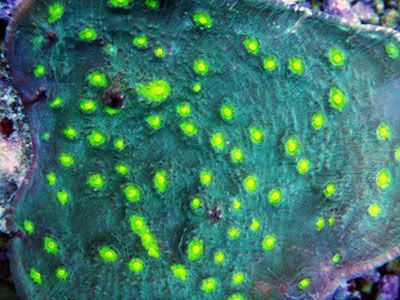
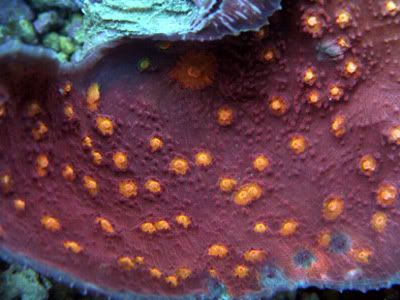
The most common and well-known of the chalice corals are those from the genus Oxypora. These often have stunning spirals of wafer-thin plates rising from their thick base. Large irregularly spaced corallites are visible, and it's from these corallites that the animal's polyps and stinging sweeper tentacles emerge. It is important to give this animal an ample buffer zone so it does not sting other sessile invertebrates. These corals do best with brighter lighting and lower flow situations, although like most corals in the family, they are quite tolerant of a wide range of conditions.
Mycedium
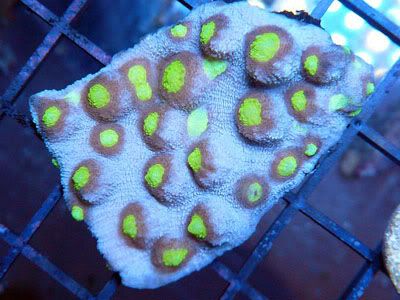
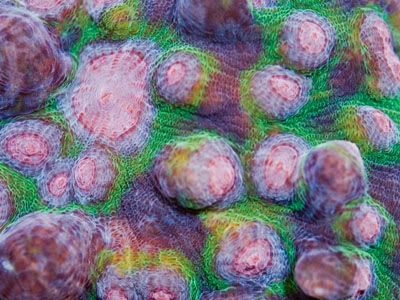
Oxypora species are frequently confused with corals from the genus Mycedium. While both may be called chalice corals, Mycedium species are more commonly called elephant nose coral or peacock coral. The corallites of Mycedium species angle toward the outer perimeter of the coral, and this is the easiest way to tell the difference between the two. In addition to their stinging sweeper tentacles, Mycedium species can release toxins into the water as a means of competing with neighboring corals, especially soft corals. Mycedium species are fairly tolerant of varying degrees of lighting and current, and deep water varieties can also do well in low light and shaded situations.
Echinophyllia
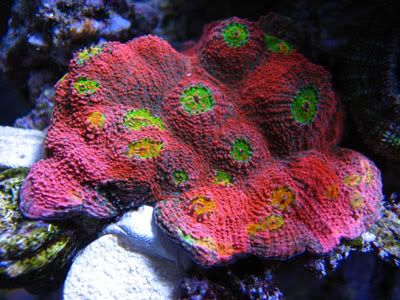
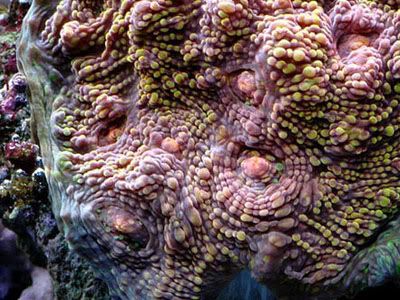
Echinophyllia species are favorites amongst reef aquarist looking for a brightly colored, chalice coral. Frequently more colorful than either Oxypora or Mycedium species, Echinophyllia are perhaps even hardier and more tolerant of varying lighting and flow conditions. These corals are capable of aggressive behavior, as they also possess long stinging sweeper tentacles.
Echinopora - Not Part of the Family
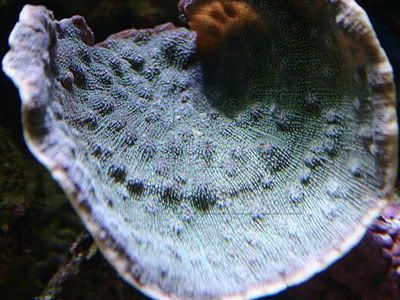
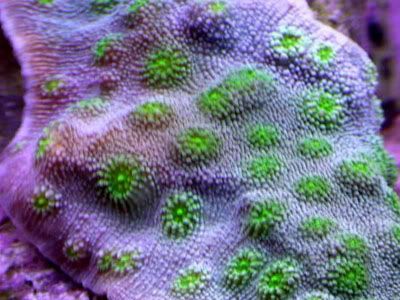
Chalice corals from the genus Echinophyllia are often confused with chalice corals from the genus Echinopora. The genus Echinopora is part of the Family Faviidae, which also includes such aquarium favorites as trumpet coral (Caulastrea species) and moon, pineapple or closed brain coral (Favia species). While Echinopora is indeed a Faviid, it can take on a chalice growth pattern. Chalice corals from the genus Echinopora are frequently misidentified as Mycedium or Oxypora species. Echinopora specimens are very hardy and tolerant of varying lighting and flow situations, but they seem to do best in bright light situations with at least moderate current.
Echinomorpha
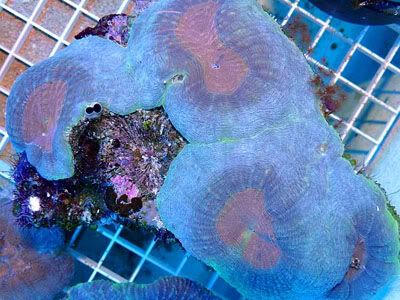
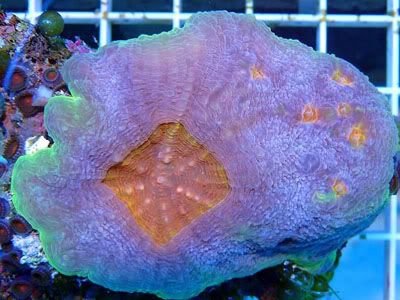
Chalice corals from the genus Echinomorpha belong to the Family Pectiniidae. There is only one species in the genus, and it is a beauty. Like most of the other corals described, it is a fairly hardy animal that is extremely light tolerant, although it displays its best colors under bright lights
For more Information on Chalice Species See Link: http://www.bluezooaquatics.com/resources.asp?show=381http://www.bluezooaquatics.com/resources.asp?show=381
Chalice Care
Often seen in the shape of a cup, chalice corals grow thin and flat with many bumps, sometimes in a plating fashion, and sometimes encrusting. Though they come into stores lacking much color, these corals will turn into just about any color of the rainbow.
Environment - Reef. Indo Pacific.
Lighting - Tends to enjoy medium reef lighting conditions and will show it with lots of color. One of the few corals that can color up as
much or more under PCs and VHOs than Halides. If put under halides, place low in the tank or in some shade for best color.
Current - Medium current.
Aggressiveness - Though there are some reports of high aggression from these corals, most have great luck with them and can keep them near other non-aggressive corals without issue.
Feeding - Nocturnal feeders. Will accept small meaty foods.
Supplements - A stony coral, therefore requiring good levels of calcium and carbonates along with other trace elements.
Position - Will do great in the sand, as well as on the rock structure if placed securely. Generally placed low to middle of the tank due to lighting needs.
Reproduction - Asexual fragmentation acheived successfully with hammer and small chisel. For thinner specimens, a razor and a bit of force is all that is needed. Even small penny sized peices of this coral will grow into a lorge colony given time.
Natural Predators - There have been reports about crabs, about the size of a pinhead, that occasionally come in on the chalices and are thought to be a coralivore. These crabs will reportedly burrow into the tissue and eat the coral from the inside out. The verdict is still out, but any damaged chalice should be thoroughly inspected.

Family:
Pectiniidae
Common Genus:
Echinomorpha, Echinophyllia, Oxypora, Mycedium, Pectinia, Physophyllia
Common Names:
Chalice, Lettuce Coral, Plate Coral
Chalice corals are not corals of a single species, from a single genus or even from a single family. Instead, the term chalice is often used to refer to a growth form that resembles a cup or chalice. Many different species of coral within different genera and even different families display this growth form.
Most of the popular chalice corals come from the Family Pectiniidae, which is currently composed of at least six genera.
* Echinophyllia
* Mycedium
* Oxypora
* Pectinia
* Physophyllia
* Echinomorpha
These are all stony corals, and they are commonly referred to by hobbyists as chalice, scroll, elephant nose, peacock, lettuce, plate, antler, palm, and hibiscus coral. Most commonly seen in the hobby are colorful, slow-growing animals. All the known species are zooxanthellate, which means they host symbiotic algae within their tissue. Many are considered fairly hardy and should do well in an established stable tropical reef aquarium.
Oxypora spp.


The most common and well-known of the chalice corals are those from the genus Oxypora. These often have stunning spirals of wafer-thin plates rising from their thick base. Large irregularly spaced corallites are visible, and it's from these corallites that the animal's polyps and stinging sweeper tentacles emerge. It is important to give this animal an ample buffer zone so it does not sting other sessile invertebrates. These corals do best with brighter lighting and lower flow situations, although like most corals in the family, they are quite tolerant of a wide range of conditions.
Mycedium


Oxypora species are frequently confused with corals from the genus Mycedium. While both may be called chalice corals, Mycedium species are more commonly called elephant nose coral or peacock coral. The corallites of Mycedium species angle toward the outer perimeter of the coral, and this is the easiest way to tell the difference between the two. In addition to their stinging sweeper tentacles, Mycedium species can release toxins into the water as a means of competing with neighboring corals, especially soft corals. Mycedium species are fairly tolerant of varying degrees of lighting and current, and deep water varieties can also do well in low light and shaded situations.
Echinophyllia


Echinophyllia species are favorites amongst reef aquarist looking for a brightly colored, chalice coral. Frequently more colorful than either Oxypora or Mycedium species, Echinophyllia are perhaps even hardier and more tolerant of varying lighting and flow conditions. These corals are capable of aggressive behavior, as they also possess long stinging sweeper tentacles.
Echinopora - Not Part of the Family


Chalice corals from the genus Echinophyllia are often confused with chalice corals from the genus Echinopora. The genus Echinopora is part of the Family Faviidae, which also includes such aquarium favorites as trumpet coral (Caulastrea species) and moon, pineapple or closed brain coral (Favia species). While Echinopora is indeed a Faviid, it can take on a chalice growth pattern. Chalice corals from the genus Echinopora are frequently misidentified as Mycedium or Oxypora species. Echinopora specimens are very hardy and tolerant of varying lighting and flow situations, but they seem to do best in bright light situations with at least moderate current.
Echinomorpha


Chalice corals from the genus Echinomorpha belong to the Family Pectiniidae. There is only one species in the genus, and it is a beauty. Like most of the other corals described, it is a fairly hardy animal that is extremely light tolerant, although it displays its best colors under bright lights
For more Information on Chalice Species See Link: http://www.bluezooaquatics.com/resources.asp?show=381http://www.bluezooaquatics.com/resources.asp?show=381
Chalice Care
Often seen in the shape of a cup, chalice corals grow thin and flat with many bumps, sometimes in a plating fashion, and sometimes encrusting. Though they come into stores lacking much color, these corals will turn into just about any color of the rainbow.
Environment - Reef. Indo Pacific.
Lighting - Tends to enjoy medium reef lighting conditions and will show it with lots of color. One of the few corals that can color up as
much or more under PCs and VHOs than Halides. If put under halides, place low in the tank or in some shade for best color.
Current - Medium current.
Aggressiveness - Though there are some reports of high aggression from these corals, most have great luck with them and can keep them near other non-aggressive corals without issue.
Feeding - Nocturnal feeders. Will accept small meaty foods.
Supplements - A stony coral, therefore requiring good levels of calcium and carbonates along with other trace elements.
Position - Will do great in the sand, as well as on the rock structure if placed securely. Generally placed low to middle of the tank due to lighting needs.
Reproduction - Asexual fragmentation acheived successfully with hammer and small chisel. For thinner specimens, a razor and a bit of force is all that is needed. Even small penny sized peices of this coral will grow into a lorge colony given time.
Natural Predators - There have been reports about crabs, about the size of a pinhead, that occasionally come in on the chalices and are thought to be a coralivore. These crabs will reportedly burrow into the tissue and eat the coral from the inside out. The verdict is still out, but any damaged chalice should be thoroughly inspected.